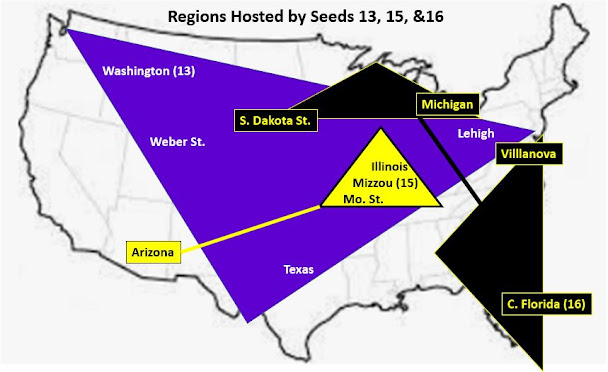I'm a little late this year with my annual geospatial maps, showing where teams are from and where they are being sent for the NCAA regionals. I experimented with different formats until I found one that I liked. As you'll see, many regionals feature three teams that are geographically near each other plus one team from a greater distance. In all cases, the one nationally seeded team within a region (shown with a seed number in parentheses) will host. Each region is depicted in the school colors of the host school. Also, to minimize clutter, I show no more than four regions per map. Play begins tomorrow.
One interesting statistic before we begin: Four conferences account for 33 teams -- more than half -- of the 64-team field. There are 12 SEC teams, eight Pac-12 teams (out of nine softball-playing schools), seven Big 10 [abbreviated B1G] teams, and six ACC teams.
The first map displays the regionals hosted by the top four seeded teams (you can click on the graphics to enlarge them). Defending Women's College World Series champion Oklahoma, which finished the season with a 49-2 record, is the No. 1 seed, The Sooners shouldn't have too much trouble in their regional, consisting of Texas A&M (12th place in the SEC), Minnesota (ninth in the B1G), and Prairie View A&M (owner of a 20-28 overall record and in the NCAA field by winning its conference tournament). Last year's WCWS runner-up Florida State is the No. 2 seed, with Virginia Tech at No. 3, and Arkansas at No. 4. This is the Razorbacks' highest national seed ever.
Shown next is the map for the No. 5-8 national seeds. At midseason, UCLA looked like a shoo-in for the No. 2 national seed, running off a 25-game winning streak. However, the Bruins went on to drop five Pac 12 contests, finishing second in the league (19-5) to Arizona State (20-4). The Sun Devils received the No. 8 seed, presumably because their nonconference schedule was not as strong as the Bruins'. Perennial power Alabama is seeded sixth and Oklahoma State, which stunned Oklahoma in the Big 12 tournament final after being swept by the Sooners in regular-season conference play, comes in at No. 7.
Due to map congestion, the next one shows only the regions hosted by the No. 9-11 teams. These include B1G regular-season champion Northwestern at No. 9, Clemson at No. 10, and Tennessee at No. 11.
The next map illustrates the No. 13, 15, and 16 regionals (leaving out No. 14 due to congestion). Many of the teams in these regions have seen better days. Washington, at No. 13, hosts a group of teams that includes unseeded Texas. Eight-time WCWS champion Arizona, in its first season after the retirement of coach Mike Candrea, is unseeded in the No. 15 Missouri (Mizzou) regional. U of A tied for last in the Pac 12 with Cal (each at 8-16). However, the Wildcats' overall record (33-20) was clearly better than Utah's (9-15, 27-27) and Cal's (28-27-1). Finally, Michigan is unseeded in the No. 16 Central Florida regional (the Knights' first hosting opportunity).






